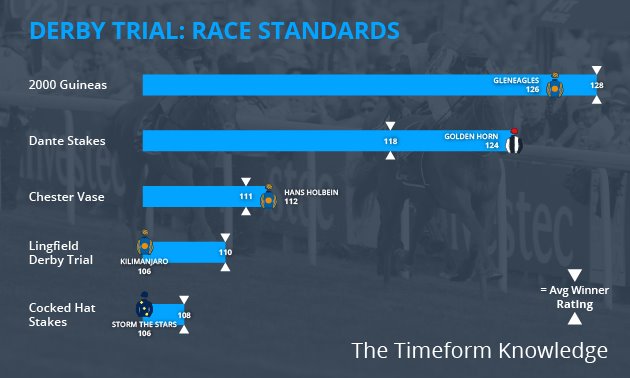Race standardisation takes past runnings of a race, or similar races, establishes the performance levels achieved by the principals in those races, adjusts for things like field size, margins between horses and so on, and outputs ratings for the current race on that basis.
These race-standardisation figures may then be merged with ratings arrived at by other means, notably those derived from the prior ratings of the horses themselves.

After converting the margins between the horses (plus any adjustments for weights carried and age) into a “difference at the weights”, shown in the “As Lbs” column, the historical figures for the race can be considered.
It can be seen that the first three in the 2015 Dante Stakes at York have all been assessed as better than the average winner/second/third in the race, if not by much: Golden Horn’s rating is 6 higher than for an average winner; Jack Hobbs’ rating is 3 higher than for an average runner-up; and Elm Park’s rating is 1 higher than for an average third.
Against that, the soundly-beaten fourth and fifth (and sixth and seventh, not shown) are considered to have run to ratings markedly lower than would usually be the case in this race.
Standardisation strikes a balance between what might be expected of horses which finish close up in a given race and the degree of superiority they have shown over others. This year’s Dante looked strong beforehand and strong for the principals – but not for the also-rans – after it, too.

A 2000 Guineas winner has been rated 10 lb higher on average than a winner of the Dante (128, compared to 118) in recent years, but Gleneagles, who went on to win the Irish 2000 Guineas, appears to be fractionally below standard. A similar comment applies to the runner-up, Territories, but third to fifth are rated above the usual figures.
What would be surprising, though not definitely wrong, would be if all the principals ran markedly better or worse than suggested by historical precedent. That is not the case with the Dante or the Guineas.
Eighth-placed Moheet (ran to 105, where 99 is average) looks to have his work cut out if he goes to Epsom.

Some Chester Vase winners have been very good – none more so than 140-rated Shergar in 1981 – and some others have also gone on to Epsom glory (Ruler of The World won both races in 2013), but most recent ones have been barely Group calibre on the day.
Hans Holbein and Storm The Stars look up to scratch for first-two finishers in the Chester Vase, but not significantly better than that. A higher assessment of the race would have third and fourth even further ahead of the historical pars, which would be difficult to justify.

Lingfield’s Derby Trial has provided several winners of The Derby at Epsom but has rather fallen out of favour of late and was downgraded from Group 3 to listed status in 2013. That is partly why a slightly negative view has been taken of this year’s race.

The Cocked Hat Stakes (or Predominate Stakes as it was once known) was won by one of the best Derby winners in Troy, in 1979, and by another great in Dubai Millennium in 1999, but is merely a useful listed contest on the whole nowadays.
An average Chester Vase runner-up (109 Timeform rating) should be good enough to win it given the winner’s average of 108, and that’s exactly what Storm The Stars did in a standard year.

It has, however, been a rather odd year for The Derby, with few horses coming through the conventional trials and a number of others from unexpected sources talked of as possibles.
These include: Success Days (at 114, an up-to-scratch winner of a substandard Derrinstown Derby Trial); Zawraq (at 110, a par winner of the 2000 Guineas Trial at Leopardstown but raised to 116 for the manner of his win); Epicuris (ran to 108 when second in Longchamp’s Prix la Force but went too fast that day and rated 114 on two-year-old form); Found (115 reflects a typical Irish 1000 Guineas runner-up); and Giovanni Canaletto (107 for second in Gallinule Stakes).
Race standards tell us not only what to expect retrospectively but what to expect in the future, at least in general terms.
The average ratings for The Derby at Epsom are:

Horses running in The Derby, at the beginning of June in their first or second season, are often still progressing, but those benchmarks give an indication of how far they still need to go, if they have not got there already.
Horses do not obligingly run to averages every time, of course: if they did there would be insufficient intrigue and uncertainty to make betting on horseracing the enthralling activity it actually is!
They have to encounter different conditions, favourable and unfavourable circumstances, they improve and deteriorate in ways that cannot easily be predicted, and they run well and badly for reasons we cannot begin to explain.
But ratings, which record how well they have run and how well they may yet run, provide an easy-to-follow framework around which performance can be weighed and measured. A good understanding of ratings will always be a powerful weapon in the punter’s arsenal.
Click here for a free Timeform Race Pass for the Derby at Epsom






















.jpg)


 Url copied to clipboard.
Url copied to clipboard.



.jpg&w=300)
.jpg&w=300)

.jpg&w=300)

.jpg&w=300)

























